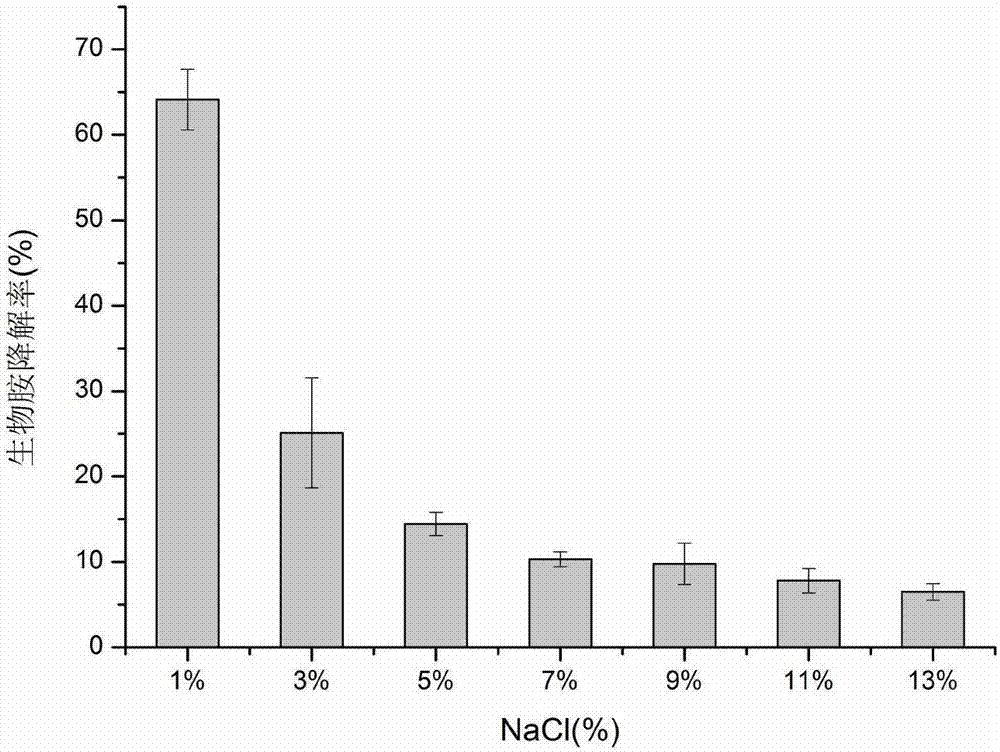Bacillus subtilis strain capable of reducing biogenic amine content, and applications thereof
A technology of Bacillus subtilis and biogenic amines, which is applied to Bacillus subtilis and its application fields, can solve the problems of affecting flavor and not suitable for the production process of bean paste, and achieves the effect of controlling the content of biogenic amines
- Summary
- Abstract
- Description
- Claims
- Application Information
AI Technical Summary
Problems solved by technology
Method used
Image
Examples
Embodiment 1
[0018] The screening of embodiment 1 subtilis
[0019] Take 1g sample from the traditional fermented bean paste fermented bean paste for about 30 days, add it to 9mL sterile water, shake it on a shaker at 30°C at 200rpm for 30min to make a suspension, dilute the suspension gradiently, and spread it on the LBGL plate. Aerobic culture at 37°C for 24h. Pick a single colony without purple halo or a small halo and repeat the plate streak separation, repeat three times to obtain a purified single colony for the next step of identification.
[0020] The -80°C glycerol stock solution was inoculated in LB medium with 1-2% of the inoculum amount, and cultured with shaking at 37°C for 24 hours, and the genomic DNA was extracted by the CTAB method. Use bacterial universal primer pair 27F / 1401R to amplify 16s rDNA. The reaction conditions are: pre-denaturation at 94°C for 3 minutes and then enter the following cycle: denaturation at 94°C for 40s, annealing at 56°C for 35s, extension at 72...
Embodiment 2
[0021] Example 2 Degradation of biogenic amine by Bacillus subtilis CGMCC No.13214
[0022] Prepare LBBA medium: peptone 10g / L; yeast powder 5g / L; NaCl 10g / L; putrescine 1g / L; cadaverine 1g / L; histamine 1g / L; tyramine 1g / L, pH natural. Dispense 10mL in a 50mL Erlenmeyer flask, and sterilize at 121°C for 20min.
[0023] Inoculate -80°C glycerol stock solution into fresh LB liquid medium with 1% inoculum amount (by volume ratio), and inoculate on a shaker at 37°C for 12 hours at a rotation speed of 200 rpm. Then inoculate LBBA liquid culture medium with 1% inoculum amount (by volume ratio), cultivate after 4 days, detect the concentration of residual biogenic amine in the culture medium by HPLC method, compare with blank control, inoculate the culture medium of Bacillus subtilis, The degradation rates of biogenic amines were: putrescine 59.30±0.59%, cadaverine 68.57±0.48%, histamine 61.92±1.14%, tyramine 63.95±0.51%.
[0024] Simultaneously, with 3% inoculum size (by volume ra...
Embodiment 3
[0025] Example 3 Degradation of Bacillus subtilis CGMCC No.13214 to biogenic amines in fermented soy sauce
[0026] Preparation of sauce unstrained spirits culture: fermented sauce unstrained spirits in the factory for one month; 10mL 1g / L biogenic amine mixture (putrescine, cadaverine, histamine, tyramine), 30g in a 250mL Erlenmeyer flask, sterilized at 121°C for 20min.
[0027] Get 3mL of the bacterium liquid activated by the above-mentioned method and inoculate it into the fermented unstrained spirits culture, and after 7 days of static culture at 37°C, use the Bacillus subtilis CGMCC NO. Cultivate and ferment in the same manner as above. The concentration of remaining biogenic amines and the main flavor substances in the culture were detected by HPLC. Compared with the blank control, the degradation rates of biogenic amines in the sauce fermented grains inoculated with Bacillus subtilis were: putrescine 33.68±0.35%, cadaverine 47.38±0.28%, histamine 15.57±0.22%, tyramine ...
PUM
 Login to View More
Login to View More Abstract
Description
Claims
Application Information
 Login to View More
Login to View More - R&D
- Intellectual Property
- Life Sciences
- Materials
- Tech Scout
- Unparalleled Data Quality
- Higher Quality Content
- 60% Fewer Hallucinations
Browse by: Latest US Patents, China's latest patents, Technical Efficacy Thesaurus, Application Domain, Technology Topic, Popular Technical Reports.
© 2025 PatSnap. All rights reserved.Legal|Privacy policy|Modern Slavery Act Transparency Statement|Sitemap|About US| Contact US: help@patsnap.com

